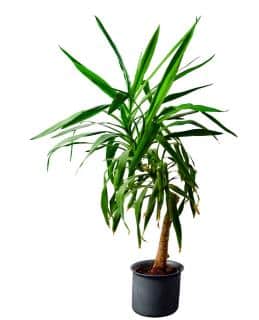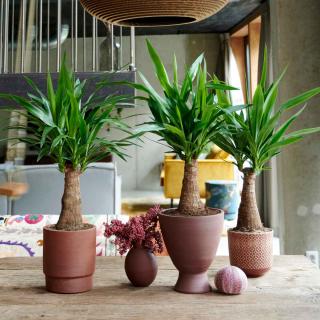

How to grow and specific care that’s needed for a yucca.
List of Yucca facts
Name – Yucca elephantipes
Type – Shrub, indoor plant
Height – 5 to 8 feet (1.5 to 2.5 m) indoors
Exposure – Very well-lit
Soil – soil mix
Foliage – evergreen
These are the answers to the many questions that can arise when one has the luck of owning a magnificent yucca.
A must-have among the indoor plants, here are our tips to care for it perfectly.
Yucca requires good soil mix, which you can amend with ⅓ compost if you have some.

This will help ensure that roots won’t wallow in water, which could be fatal to it.
Generally speaking, yucca doesn’t tolerate the cold and can only be planted outdoors in regions where the climate in winter is mild.
Just as might be done in pots, feel free to place a bed of gravel, small stones or clay pebbles to ensure proper drainage.
Atop this layer, you’ll be using a blend of soil mix, garden soil and sand.
Under our climates, yucca adapts well to living indoors in our apartments and homes.
It grows best when surrounding temperatures hold around 65 to 72°F (18 to 22°C) and requires very good light, even some direct sunlight.
Best to place it near a window facing to the West so that it would still have a good deal of light.

For strong growth and magnificent leafage, you can add leaf plant fertilizer.
This is usually the time of the year when yucca grows most.
Watering must be regular but limited, in order to not suffocate the plant’s roots.
More or less every two weeks, you can offer it some liquid fertilizer, taking great care to moisten the soil mix beforehand.
Start reducing the watering because the plant water needs begin to decrease.
But this also depends on where your yucca is placed: if it is in full sun, its needs will surely be higher.
Yucca is a very beautiful plant native to Central America that adapts very well to indoor life in an apartment or house.
All in one aesthetic, resilient and very easy to grow, this is one of the most appreciated and often-purchased indoor plants.
Its foliage is particularly elegant and brings a touch of exotic life to a living room, dining area, or any other room of the house that is well-lit.
This is undoubtedly due to lack of light or excess water.
If the plant continues to produce new leaves, this is part of your yucca’s natural cycle.
Trees, even evergreen trees, lose their leaves to renew them.
Read also:
We live in Northern France and we get very hot summers (usually) and very cold Winters, so come late autumn I bring in the Yukka plants and put them in a bright unheated spare bedroom. I do not water them at all until spring when they go outside again. I have successfully chopped off the tops if they get too long and straggly and repot them to grow on. The parent plant always grows big and bushy, sometimes from the base but also on the cut stem.